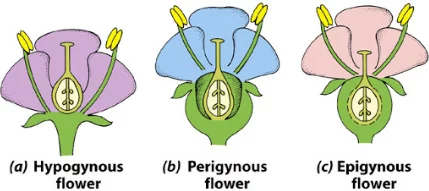Generally, a flower is the reproductive organ of flowering plants, containing sepals, petals, pistils and stamens. Based on the position of calyx, corolla and androecium in respect of the ovary on thalamus (receptacle), the flowers can be described as Hypogenous, Perigynous or Epigynous.
What Is A Hypogenous Flower?
Hypogenous flower is a flower in which the perianth and stamens are attached to the receptacle below the gynoecium; the ovary is superior to these organs and the remaining floral organs arise from below the point of origin of the carpel.
Examples of hypogenous flowers are:
- Persimmon
- Tomato
- Tulip
- Snapdragon
- True berries
- Drupes
- China rose
- Brinjal
- Mustard
- Annonaceae
What You Need To Know About Hypogenous Flower
- Hypogenous flower refers to the flower having the floral parts such as sepals, petals and stamen borne on the receptacle beneath the ovary.
- Hypogenous flowers have a superior ovary.
- The hypogenous flower has an androperianth attached to the receptacle below the ovary.
- The development of the constituents of the androperianth occurs separately and in a well-spread manner.
- Thalamus is convex or conical in hypogenous flowers.
- Thalamus is not fused with the wall of ovary.
- Whole of the pistil is visible from outside.
- No part of the thalamus is expanded except for a central projection.
What Is A Perigynous Flower?
In Perigynous flower, a hypanthium (a floral tube formed from the fusion of the stamens, sepals and petals) is attached to the receptacle below the gynoecium and surrounds the ovary; the ovary is superior and the free parts of the petals, sepals and stamens are attached to the rim of the hypanthium.
Examples of Perigynous flowers are:
- Prunus
- Cherry
- Plum
- Rose
- Peach
What You Need To Know About Perigynous Flower
- Perigynous flower refers to a flower having sepals, petals and stamens around the edge of a cuplike receptacle containing the ovary, as in flowers of the rose or cherry.
- Ovary is superior, other parts are inferior.
- Androperianth is borne around or above the level of ovary.
- Constituents of androperianth usually develop from the a common base.
- Thalamus is disc-shaped, cup-shaped or flask-shaped.
- Thalamus is free from ovary wall.
- Whole pistil may or may not be visible from outside.
- Periphery of the thalamus is expanded to form hypanthium.
What Is A Epigynous Flower?
In Epigynous flowers, the hypanthium is fused to the gynoecium, and the free parts of the sepals, petals and stamens appear to be attached to the top of the gynoecium as in the apple where the ovary is inferior and the petals, sepals and stamens appear to arise from the top of the ovary.
Examples of Epigynous flower are:
- Apple
- Daffodil
- Cucumber
- Guava
- Ray florets of sunflower
- Orchids
What You need to know About Epigynous Flower
- Epigynous flowers refers to the flowers having the floral parts such as the petals and stamens attached to or near the upper part of the ovary.
- Epigynous flowers have an inferior ovary while other parts are superior
- The Epigynous flower has an androperianth attached to the top of the ovary.
- Constituents of androperianth develop jointly from the neck of hollowed out thalamus.
- Thalamus is usually flask shaped.
- Thalamus is fused with the wall of the ovary.
- Only style and stigma are visible from outside.
- Thalamus is hollowed out.

Also Read: Difference Between Pollination And Fertilization In Flowering Plants
Difference Between Hypogenous, Perigynous And Epigynous Flower In Tabular Form
| BASIS OF COMPARISON | HYPOGENOUS FLOWER | PERIGYNOUS FLOWER | EPIGYNOUS FLOWER |
| Description | Hypogenous flower refers to the flower having the floral parts such as sepals, petals and stamen borne on the receptacle beneath the ovary. | Perigynous flower refers to a flower having sepals, petals and stamens around the edge of a cuplike receptacle containing the ovary, as in flowers of the rose or cherry. | Epigynous flowers refers to the flowers having the floral parts such as the petals and stamens attached to or near the upper part of the ovary. |
| Ovary | Hypogenous flowers have a superior ovary. | Ovary is superior, other parts are inferior. | Epigynous flowers have an inferior ovary while other parts are superior |
| Androperianth | The hypogenous flower has an androperianth attached to the receptacle below the ovary. | Androperianth is borne around or above the level of ovary. | The Epigynous flower has an androperianth attached to the top of the ovary. |
| The Constituents Of Androperianth | The development of the constituents of the androperianth occurs separately and in a well-spread manner. | Constituents of androperianth usually develop from the a common base. | Constituents of androperianth develop jointly from the neck of hollowed out thalamus. |
| Thalamus | Thalamus is convex or conical in hypogenous flowers. | Thalamus is disc-shaped, cup-shaped or flask-shaped. | Thalamus is usually flask shaped. |
| Thalamus | Thalamus is not fused with the wall of ovary. | Thalamus is free from ovary wall. | Thalamus is fused with the wall of the ovary. |
| Pistil | Whole pistil may or may not be visible from outside. | Whole pistil may or may not be visible from outside. | Only style and stigma are visible from outside. |
| Periphery Of Thalamus | Periphery of the thalamus is expanded to form hypanthium. | Periphery of the thalamus is expanded to form hypanthium. | Thalamus is hollowed out. |
Also Read: Difference Between True And False Fruit